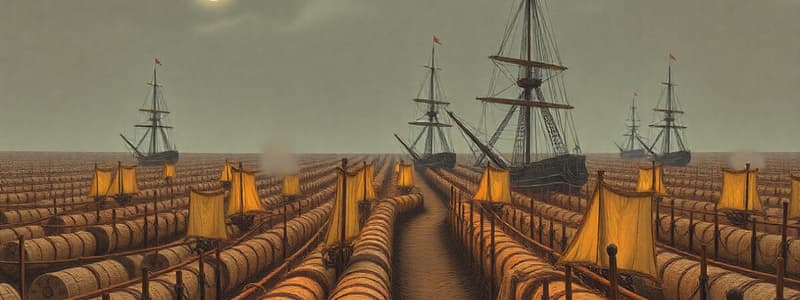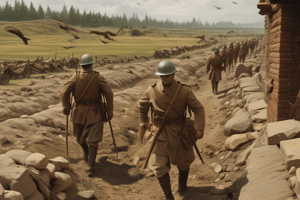Podcast
Questions and Answers
What event occurred during Christmas of 1914 involving Anglo-French and German soldiers?
What event occurred during Christmas of 1914 involving Anglo-French and German soldiers?
- They suspended fighting and exchanged gifts. (correct)
- They signed a peace treaty.
- They launched a coordinated attack on the enemy.
- They agreed to a permanent ceasefire.
What was one of the consequences of using poison gas in WWI?
What was one of the consequences of using poison gas in WWI?
- It boosted troop morale significantly.
- It was immediately banned by international treaties.
- It shocked the world and increased the horror of war. (correct)
- It led to a swift resolution of trench warfare.
Which battle was notably led by General Paul von Hindenburg on the Eastern Front?
Which battle was notably led by General Paul von Hindenburg on the Eastern Front?
- Battle of Tannenberg (correct)
- Battle of the Somme
- Battle of Ypres
- Battle of Verdun
What was a significant action taken by German U-boats during WWI?
What was a significant action taken by German U-boats during WWI?
What stance did Italy take at the beginning of World War I?
What stance did Italy take at the beginning of World War I?
Which of the following contributed to Italy's difficulties in joining World War I?
Which of the following contributed to Italy's difficulties in joining World War I?
What was the reaction of the United States to the sinking of the Lusitania?
What was the reaction of the United States to the sinking of the Lusitania?
Which groups constituted the Neutralists in Italy during World War I?
Which groups constituted the Neutralists in Italy during World War I?
What motivated the interventionists in Italy during World War I?
What motivated the interventionists in Italy during World War I?
Which event led to Italy's decision to join the Allies in 1915?
Which event led to Italy's decision to join the Allies in 1915?
What was the primary focus of factories in Italy during the war?
What was the primary focus of factories in Italy during the war?
What characterized trench warfare on the Italian front?
What characterized trench warfare on the Italian front?
What was the result of the Battle of Caporetto for Italy?
What was the result of the Battle of Caporetto for Italy?
Which event is considered a turning point in World War I?
Which event is considered a turning point in World War I?
What was one of the outcomes of the collapse of Austria-Hungary?
What was one of the outcomes of the collapse of Austria-Hungary?
What was the relationship between colonialism and nationalism during this era?
What was the relationship between colonialism and nationalism during this era?
What ideology did Bismarck focus on for securing Germany’s position?
What ideology did Bismarck focus on for securing Germany’s position?
What was a defining feature of the Armenian Genocide during World War I?
What was a defining feature of the Armenian Genocide during World War I?
Which statement accurately describes Pan-Slavism?
Which statement accurately describes Pan-Slavism?
What social issue affected the Russian Empire, contributing to its challenges?
What social issue affected the Russian Empire, contributing to its challenges?
What was the central idea behind the 'White Man’s Burden' theory?
What was the central idea behind the 'White Man’s Burden' theory?
Flashcards
Western Front
Western Front
Military conflict between the Allied powers (France, Britain, Russia) and the Central powers (Germany, Austria-Hungary) primarily fought in the trenches along the border between France and Germany.
Eastern Front
Eastern Front
The German and Austrian forces effectively stopped the Russian advance, despite the Russians having a large army. This was due to the Germans having superior technology and leadership.
Poison Gas in WWI
Poison Gas in WWI
The use of poisonous gas by the Germans in 1915, aimed to break trench warfare. It horrified the world and made trench warfare even more brutal.
German U-boats
German U-boats
Signup and view all the flashcards
Sinking of the Lusitania
Sinking of the Lusitania
Signup and view all the flashcards
Italy's Neutrality in WWI
Italy's Neutrality in WWI
Signup and view all the flashcards
Neutralists in Italy
Neutralists in Italy
Signup and view all the flashcards
Interventionists in Italy
Interventionists in Italy
Signup and view all the flashcards
Irredentism
Irredentism
Signup and view all the flashcards
Nationalism
Nationalism
Signup and view all the flashcards
Patriotism
Patriotism
Signup and view all the flashcards
Colonialism
Colonialism
Signup and view all the flashcards
The White Man's Burden
The White Man's Burden
Signup and view all the flashcards
The Triple Alliance (1882)
The Triple Alliance (1882)
Signup and view all the flashcards
Battle of Caporetto (1917)
Battle of Caporetto (1917)
Signup and view all the flashcards
Battle of Isonzo
Battle of Isonzo
Signup and view all the flashcards
Alpini
Alpini
Signup and view all the flashcards
Armenian Genocide
Armenian Genocide
Signup and view all the flashcards
Horrors of trench warfare
Horrors of trench warfare
Signup and view all the flashcards
Russia's Withdrawal from World War I
Russia's Withdrawal from World War I
Signup and view all the flashcards
Treaty of Brest-Litovsk
Treaty of Brest-Litovsk
Signup and view all the flashcards
Collapse of the Austro-Hungarian Empire
Collapse of the Austro-Hungarian Empire
Signup and view all the flashcards
Study Notes
Western Front
- Christmas 1914: Fighting ceased briefly, soldiers exchanged gifts, and played football in no man's land.
- Trench warfare resulted in immense casualties: over 400,000 dead and 1 million wounded.
- 1915: Poison gas employed, marking a horrifying new phase of warfare; chlorine gas first used at Ypres.
Eastern Front
- German-Austrian forces successfully halted Russian advances, despite Russia having a large army.
- Russian army's lack of modern weaponry and equipment compared to the Germans was a significant disadvantage.
- General von Hindenburg led German victories at Tannenberg and Masurian Lakes.
- Eastern Front characterized by long, entrenched battles, similar to the Western Front.
Naval Warfare
- German U-boats (submarines) attacked enemy ships.
- U-boats blockaded Britain to cut off supplies to the Allies.
- May 1915: Sinking of the Lusitania, a British passenger ship, killing many civilians, including Americans, causing outrage and drawing the US closer to the Allies.
Italy's Role in the War
- Initially neutral, despite being part of the Triple Alliance (with Germany and Austria-Hungary).
- Italy argued the alliance was defensive, and Austria-Hungary acted offensively.
- Internal divisions characterized by neutralist and interventionist factions.
- Neutralists (Catholics, socialists, Giolitti).
- Interventionists (nationalists, revolutionary socialists, futurists, D’Annunzio).
- Interventionists aimed at reclaiming territories from Austria-Hungary.
- Italy eventually joined the Allies.
Italy Mobilizes
- 1915: Signed Treaty of London, committing to the Allied side for lands like Trentino, Istria, and Dalmatian Coast.
- Wartime mobilization escalated: 125,000 workers in 1915, increasing to 976,000 by 1918 (including 900,000 women).
- War effort prioritized production, suppressing strikes and protests, banning unions.
Trench Warfare in Italy
- Italian Front mirrored the Western Front's trench warfare horrors.
- Harsh conditions: lack of food, water, and cold alpine winters.
- Diseases (trench foot and typhus) spread rapidly among soldiers, especially Alpini mountain troops.
Key Battles on the Italian Front
- Battle of Isonzo: 11 offensives yielded minimal gains, significant casualties.
- Battle of Carso: Major Italian losses, over half a million soldiers.
- Battle of Caporetto (1917): Austro-German victory, 300,000 Italian prisoners, significant retreat.
The Turning Point of 1917 and the End of the War
- 1917
- Russia's Withdrawal: Bolshevik Revolution and the Treaty of Brest-Litovsk.
- United States Entry: German unrestricted submarine warfare and Lusitania sinking prompted US involvement.
- 1918
- Austria-Hungary's Collapse: Internal revolts and Italian counteroffensive (Battle of Vittorio Veneto) leading to surrender.
- Germany's Defeat: Kaiser Wilhelm II abdicated, Armistice signed November 11, marking the end of the war.
- Ottoman Empire's Collapse: Loss of all territories outside Turkey.
Aftermath
- Armenian Genocide: Ottoman Turks' slaughter of 1.5 million Armenians.
- Political Changes: Austro-Hungarian Empire dissolved into new nations (Czechoslovakia, Yugoslavia); Germany transitioned to a republic.
- League of Nations formed to avoid future wars (failed).
The Balance Wavers
- Imperialism and Patriotism
- Nationalism: Extreme attachment to one's nation, often hostile to others.
- Patriotism: Balanced love of homeland, without hostility towards others.
- Colonialism: Invasion and control of foreign lands, often justified by racial superiority ("White Man's Burden").
- Colonial Investments: Germany and France exploiting resources in Africa.
- Bismarck and Diplomacy: Secured Germany's position through alliances (Triple Alliance).
- Colonial Expansion under Kaiser Wilhelm II: Aggressive pursuit of colonies and increased nationalism.
- Irredentism: Movement for reclaiming lost territories (e.g., Italy).
- Balkan Fragmentation: Tensions among diverse ethnic groups in the Balkans and their independence movements.
- Pan-Slavism: Russian-backed Slavic unity increased tensions.
Russia's Challenges
- Territorial expansion near borders rather than overseas colonies.
- Corruption, bureaucracy, illiteracy, extreme poverty in the Russian Empire.
- Oppressive feudal system controlled by the Tsarist autocracy.
Leadership Failures
- Alexander III's extreme nationalism, isolating Russia from Western alliances.
- Nicholas II's regime: Brutality and inability to address social unrest leading to revolution.
- Prelude to Revolution: Unrest resulting from social and economic problems.
Studying That Suits You
Use AI to generate personalized quizzes and flashcards to suit your learning preferences.




